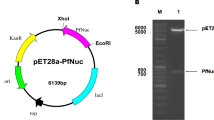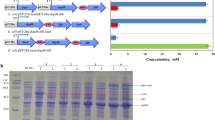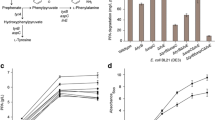Abstract
An active d-hydantoinase from Pseudomonas fluorescens was heterogeneously overexpressed in Escherichia coli BL21(DE3) and designated as d-PfHYD. Sequence and consensus analysis suggests that d-PfHYD belongs to the dihydropyrimidinase/hydantoinase family and possesses catalytic residues for metal ion and hydantoin binding. d-PfHYD was purified to homogeneity by nickel affinity chromatography for characterization. d-PfHYD is a homotetramer with molecular weight of 215 kDa and specific activity of 20.9 U mg−1. d-PfHYD showed the highest activity at pH 9.0 and 60 °C. Metal ions such as Mn2+, Fe2+, and Fe3+ could activate d-PfHYD with 20 % improvement. Substrate specificity analysis revealed that purified d-PfHYD preferred aliphatic to aromatic 5′-monosubstituted hydantoins. Among various strategies tested, chaperone GroES-GroEL was efficient in improving the soluble expression of d-PfHYD. Employing 1.0 g L−1 recombinant E. coli BL21(DE3)-pET28-hyd/pGRO7 dry cells, 100 mM isobutyl hydantoin was converted into d-isoleucine with 98.7 % enantiomeric excess (ee), isolation yield of 78.3 %, and substrate to biocatalyst ratio of 15.6. Our results suggest that recombinant d-PfHYD could be potentially applied in the synthesis of d-amino acids.





Similar content being viewed by others
References
Gao, X. Z., Ma, Q. Y., & Zhu, H. L. (2015). Distribution, industrial applications, and enzymatic synthesis of D-amino acids. Applied Microbiology and Biotechnology, 99, 3341–3349.
Zhang, J., Xu, Y. & Li, R. (2013). Preparation method of aspoxicillin. China Patent. 103333180A.
Walters, D. E. (1995). Using models to understand and design sweeteners. Journal of Chemical Education, 72, 680–683.
Omura, T. & Furukawara, T. (2014). Oil-in-water type emulsion skin cosmetic. United States Patent. 8607750B2.
Altenbuchner, J., Siemann-Herzberg, M., & Syldatck, C. (2001). Hydantoinases and related enzymes as biocatalysts for the synthesis of unnatural chiral amino acids. Current Opinion in Biotechnology, 12, 559–563.
Bommarius, A. S., Schwarm, M., & Drauz, K. (1998). Biocatalysis to amino acid-based chiral pharmaceuticals—examples and perspectives. Journal of Molecular Catalysis B: Enzymatic, 5, 1–11.
Burton, S. G., & Dorrington, R. A. (2004). Hydantoin-hydrolysing enzymes for the enatioselective production of amino acids: new insights and applications. Tetrahedron: Asymmetry, 15, 2737–2741.
Jiang, M., Shang, L. A., Wei, P., Yu, R. H., Shen, N., Ouyang, P. K., & Chang, H. N. (2007). Pilot-scale production of D-p-hydroxyphenylglycine from DL-5-p-hydroxyphenylhydantoin by Burkholderia cepacia JS-02. Enzyme and Microbial Technology, 41, 407–412.
Syldatk, C., May, O., Altenbuchner, J., & Mattes, R. (1999). Microbial hydantoinases-industrial enzymes from the origin of life? Applied Microbiology and Biotechnology, 51, 293–309.
Zhang, X. Y., Niu, L. X., Shi, Y. W., & Yuan, J. M. (2008). The flexibility of the non-conservative region at the C terminus of D-hydantoinase from Pseudomonas putida YZ-26 is extremely limited. Applied Biochemistry and Biotechnology, 144, 237–247.
Durham, D. R., & Weber, J. E. (1995). Properties of D-hydantoinase from Agrobacterium tumefaciens and its use for the preparation of N-carbamyl D-amino acids. Biochemical and Biophysical Research Communications, 216, 1095–1100.
Mukohara, Y., Ishikawa, T., Watabe, K., & Nakamura, H. (1994). A thermostable hydantinase of Bacillus stearothermophilus NS1122A: cloning, sequencing, and high expression of the enzyme gene, and some properties of the expressed enzyme. Bioscience, Biotechnology, and Biochemistry, 58, 1621–1626.
Xu, Z., Liu, Y. Q., Yang, Y. L., Jiang, W. H., Arnold, E., & Ding, J. P. (2003). Crystal structure of D-hydantoinase from Burkholderia pickettii at a resolution of 2.7 Å: insights into the molecular basis of enzyme thermostability. Journal of Bacteriology, 185, 4038–4049.
May, O., Siemann, M., Pietzsch, M., Kiess, M., Mattes, R. & Syldatk, C. (1997) Substrate-dependent enantioselectivity of a novel hydantoinase from Arthrobacter aurescens DSM 3745: Purification and characterization as new member of cyclic amidases. 61, 1–13.
Latacz, G., & Kiec-Kononowicz, K. (2014). Biotransformation of new racemic (R, S)-5-benzylhydantoin derivatives by D-hydantoinases from Adzuki bean. Biocatalysis and Biotransformation, 32, 117–124.
Su, T. M., & Yang, Y. S. (2000). Identification, purification, and characterization of a thermophilic imidase from pig liver. Protein Expression and Purification, 19, 289–297.
Ogawa, J., & Shimizu, S. (2002). Industrial microbial enzymes: their discovery by screening and use in large-scale production of useful chemicals in Japan. Current Opinion in Biotechnology, 13, 367–375.
Siemann, M., Alvarado-Marín, Á., Pietzsch, M., & Syldatk, C. (1999). A D-specific hydantoin amidohydrolase: properties of the metalloenzyme purified from Arthrobacter crystallopoietes. Journal of Molecular Catalysis B: Enzymatic, 6, 387–397.
Shi, Y. W., Niu, L. X., Feng, X., & Yuan, J. M. (2006). Purification, enzymatic properties of a recombinant D-hydantoinase and its dissociation by zinc ion. World Journal of Microbiology and Biotechnology, 22, 675–680.
Runser, S., & Ohleyer, E. (1990). Properties of the hydantoinase from Agrobacterium sp. IP I-671. Biotechnology Letters, 12, 259–264.
Cheon, Y. H., Park, H. S., Lee, S. C., Lee, D. E., & Kim, H. S. (2003). Structure-based mutational analysis of the active site residues of D-hydantoinase. Journal of Molecular Catalysis B: Enzymatic, 26, 217–222.
Lin, C. C., Liu, T. T., Kan, S. C., Zang, C. Z., Yeh, C. W., Wu, J. Y., Chen, J. H., Shieh, C. J., & Liu, Y. C. (2013). Production of D-hydantoinase via surface display and self-cleavage system. Journal of Bioscience and Bioengineering, 116, 562–566.
Chen, S. Y., Chien, Y. W., & Chao, Y. P. (2014). In vivo immobilization of D-hydatoinase in Escherichia coli. Journal of Bioscience and Bioengineering, 118, 78–81.
Kim, G. J., Lee, D. E., & Kim, H. S. (2001). High-level expression and one-step purification of cyclic amidohydrolase family enzymes. Protein Expression and Purification, 23, 128–133.
Chern, J. T., & Chao, Y. P. (2005). Chitin-binding domain based immobilization of D-hydantoinase. Journal of Biotechnology, 117, 267–275.
Ogawa, J., & Shimizu, S. (1999). Microbial enzymes: new industrial application from traditional screening methods. Trends in Biotechnology, 17, 13–20.
Ohishi, T., Nanba, H., Sugawara, M., Izumida, M., Honda, T., Mori, K., Yanagisawa, S., Ueda, M., Nagashima, N., & Inoue, K. (2007). Enantioselective synthesis of D- and L-α-methylcysteine with hydantoinase. Tetrahedron Letters, 48, 3437–3440.
Nandanwar, H. S., Prajapati, R., & Hoondal, G. S. (2013). (D)-p-Hydroxyphenylglycine production by thermostable D-hydantoinase from Brevibacillus parabrevis-PHG1. Biocatalysis and Biotransformation, 31, 22–32.
Morin, A., Hummel, W., & Kula, M. R. (1986). Production of hydantoinase from Pseudomonas fluorescens strain DSM84. Applied Microbiology and Biotechnology, 25, 91–96.
Martínez-Rodríguez, S., Martínez-Gómez, A. I., Clemente-Jiménez, J. M., Rodríguez-Vico, F., García-Ruíz, J. M., Javier, F., Heras-Vázquez, L., & Gavira, J. A. (2010). Structure of dihydropyrimidinase from Sinorhizobium meliloti CECT4114: new features in an amidohydrolase family member. Journal of Structural Biology, 169, 200–208.
Clemente-Jiménez, J. M., Martínez-Rodríguez, S., Rodríguez-Vico, F., & Heras-Vázquez, F. J. L. (2008). Optically pure α-amino acids production by the “hydantoinase process”. Recent Patents on Biotechnology, 2, 35–46.
Dobson, C. M. (2003). Protein folding and misfolding. Nature, 426, 884–890.
Acknowledgments
We are grateful to the National Natural Science Foundation of China (21276112, 21506073), the Natural Science Foundation of Jiangsu Province (BK20150003), the Fundamental Research Funds for the Central Universities (JUSRP51409B), the Program of Introducing Talents of Discipline to Universities (111-2-06), and a project funded by the Priority Academic Program Development of Jiangsu Higher Education Institutions for the financial support of this research.
Author information
Authors and Affiliations
Corresponding author
Ethics declarations
Conflicts of Interest
All the authors certify that this manuscript is original and has not been published and will not be submitted elsewhere for publication while being considered by Applied Biochemistry and Biotechnology. And the study is not split up into several parts to increase the quantity of submissions and submitted to various journals or to one journal over time. No data have been fabricated or manipulated (including images) to support your conclusions. No data, text, or theories by others are presented as if they were our own. The submission has been received explicitly from all co-authors. And authors whose names appear on the submission have contributed sufficiently to the scientific work and therefore share collective responsibility and accountability for the results. The authors declare that they have no conflict of interest. This article does not contain any studies with human participants or animals performed by any of the authors. Informed consent was obtained from all individual participants included in the study.
Electronic Supplementary Material
Below is the link to the electronic supplementary material.
ESM 1
(DOCX 1291 kb)
Rights and permissions
About this article
Cite this article
Xu, GC., Li, L., Han, RZ. et al. Characterization and Soluble Expression of d-Hydantoinase from Pseudomonas fluorescens for the Synthesis of d-Amino Acids. Appl Biochem Biotechnol 179, 1–15 (2016). https://doi.org/10.1007/s12010-015-1975-6
Received:
Accepted:
Published:
Issue Date:
DOI: https://doi.org/10.1007/s12010-015-1975-6




